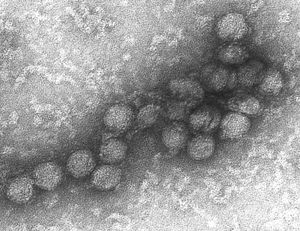Flaviviridae: Difference between revisions
No edit summary |
|||
| (19 intermediate revisions by 3 users not shown) | |||
| Line 1: | Line 1: | ||
[[Category:Short pages]] | |||
{{Curated}} | |||
{{Viral Biorealm Family}} | |||
[[Image:Flaviviridae.jpg|thumb|right|Electron micrograph of the West Nile virus, a member of the Flaviviridae family. Image Courtesy: CDC/Cynthia Goldsmith]] | |||
==Baltimore Classification== | ==Baltimore Classification== | ||
| Line 7: | Line 13: | ||
===Genera=== | ===Genera=== | ||
Flavivirus, Pestivirus, Hepacivirus | ''Flavivirus'', ''Pestivirus'', ''[[Hepacivirus]]'' | ||
==Description and Significance== | ==Description and Significance== | ||
| Line 21: | Line 27: | ||
==Virion Structure of a Flaviviridae== | ==Virion Structure of a Flaviviridae== | ||
The virions of flaviviridae consist of an envelope and a nucleocapsid. The virus capsid is enveloped. The virions ar spherical to pleomorphic and | The virions of flaviviridae consist of an envelope and a nucleocapsid. The virus capsid is enveloped. The virions ar spherical to pleomorphic and measure 40-60 nm in diameter. There are small spikes surrounded by a prominent fringe that make up the surface projections. The capsid is round and exhibits a polyhedral symmetry. The core is isometric and has a diameter of 25-30 nm. The capsids can be penetrated by stain and some appear dark in the center. (source: [http://www.ncbi.nlm.nih.gov/ICTVdb/ICTVdB/00.026.htm ICTV dB Descriptions]) | ||
==Reproduction Cycle of a Flaviviridae in a Host Cell== | |||
==Viral Ecology & Pathology== | |||
Many species of Flaviviridae can replicate in both mammalian and insect cells. They can survive for long periods in hosts such as ticks by replicating in this host without damage to the insect. | |||
Flaviviridae viruses produce a wide range of diseases including fever, arthralgia, rash, haemorrhagic fever and encephalitis. The outcome of infection is influenced by both the virus and a number of host-specific factors like age, sex, genetic susceptibility and preexposure to same or related agent. | |||
==References== | ==References== | ||
[http://www.stanford.edu/group/virus/1999/asb-flavi/overview.htm Stanford.edu] | [http://www.stanford.edu/group/virus/1999/asb-flavi/overview.htm Stanford.edu] | ||
[http://www.ncbi.nlm.nih.gov/ICTVdb/ICTVdB/00.026.htm ICTV dB Descriptions] | |||
Latest revision as of 19:41, 28 September 2015
A Viral Biorealm page on the family Flaviviridae
Baltimore Classification
Higher order taxa
Viruses; ssRNA positive-strand viruses, no DNA stage; Flaviviridae
Genera
Flavivirus, Pestivirus, Hepacivirus
Description and Significance
Flaviviridae contains a myriad of viruses that cause disease in humans. Flaviviridae has a total of 69 pathogens in its rank. The family gets its name from Yellow Fever virus, a type virus of Flaviviridae; flavus means yellow in Latin.
The Flavivirus genus contains several nasty critters that include yellow fever virus, dengue fever virus, and Japanese encephalitis (JE) virus. The pestivirus genus has three serotypes of bovine viral diarrhea, but no human pathogens are yet known. Genus Hepacivirus consists of hepatitis C virus and its relatives. (source: Stanford.edu)
Genome Structure
The genome of Flaviviridae is not segmented and contains a single molecule of linear positive-sense, single-stranded RNA. The complete genome is 9500-12500 nucleotides long. The 5'-end of the genome has a methylated nucleotide cap, or genome-linked protein (VPg). The 3'- terminus has no poly (A) tract but the poly (A) tract is present in some strains of tick-born encephalitis complex of flaviviruses. (source: ICTV dB Descriptions)
Virion Structure of a Flaviviridae
The virions of flaviviridae consist of an envelope and a nucleocapsid. The virus capsid is enveloped. The virions ar spherical to pleomorphic and measure 40-60 nm in diameter. There are small spikes surrounded by a prominent fringe that make up the surface projections. The capsid is round and exhibits a polyhedral symmetry. The core is isometric and has a diameter of 25-30 nm. The capsids can be penetrated by stain and some appear dark in the center. (source: ICTV dB Descriptions)
Reproduction Cycle of a Flaviviridae in a Host Cell
Viral Ecology & Pathology
Many species of Flaviviridae can replicate in both mammalian and insect cells. They can survive for long periods in hosts such as ticks by replicating in this host without damage to the insect.
Flaviviridae viruses produce a wide range of diseases including fever, arthralgia, rash, haemorrhagic fever and encephalitis. The outcome of infection is influenced by both the virus and a number of host-specific factors like age, sex, genetic susceptibility and preexposure to same or related agent.

